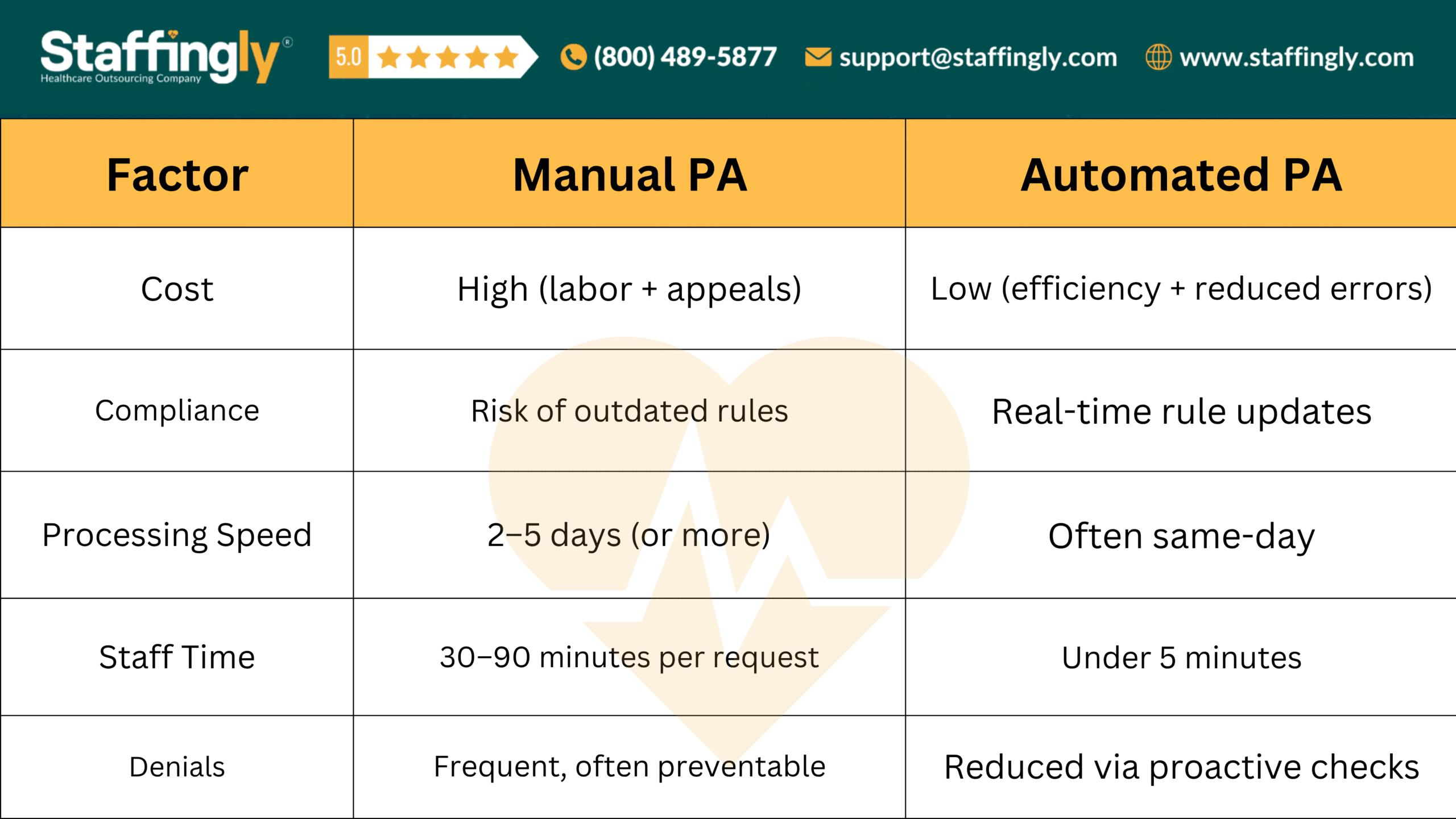On-Demand Outsourcing BPO Services for Healthcare Providers With 24/7 Coverage!
Save up to 70% on staffing costs!
Browse Specialty Staffing ServicesWhat Are the Real Benefits of Automating Prior Authorizations?

At 9:15 AM, the front desk at Dr. Martinez’s primary care clinic received a panicked call. A patient’s MRI had been postponed—again. The insurance company still hadn’t approved the scan, despite multiple faxes and follow-up calls. The diagnosis? Delayed. The patient? Anxious. The doctor? Burned out.
The paperwork bottleneck wasn’t just frustrating. It was compromising care.
The Prior Authorization Strain
In 2025, prior authorization (PA) remains one of the biggest administrative headaches in healthcare. What began as a system of checks and balances has ballooned into a time-consuming, error-prone process. Clinics spend hours chasing approvals, navigating payer portals, or waiting on hold—only to face claim rejections later.
Manual PAs drain time, morale, and revenue. But AI is changing the game.
Automated Prior Authorization Software offers a better path forward—one where approvals are streamlined, patients are treated faster, and providers finally catch a break.
Key Benefits of Automating Prior Authorizations
-
Real-Time Decisioning
Software powered by AI can instantly analyze payer rules and medical necessity criteria—submitting clean, accurate requests the first time. -
Drastic Time Savings
Automated tools slash manual steps like faxes and phone calls, freeing up hours of staff time every week. -
Fewer Errors, Higher Approval Rates
Automation flags missing data, mismatched codes, or incomplete documentation before submission—reducing rejections. -
Improved Patient Experience
Fast-tracked authorizations mean faster treatment. No more waiting weeks for a scan or medication approval. -
Reduced Denials and Appeals
By catching mistakes early, automation increases the number of claims that get approved without intervention. -
Better Staff Utilization
Instead of doing data entry, your front desk and billing teams can focus on patient-facing tasks or more strategic work. -
Compliance Without the Guesswork
Rule libraries stay updated as payer requirements change—reducing audit risk and ensuring cleaner submissions.
Manual vs. Automated: Which One Still Works?
Let’s be real: In 2025, purely manual prior authorizations just don’t hold up.
Manual systems are labor-intensive, error-prone, and disconnected. On the other hand, automated PA systems plug directly into EHRs, check eligibility in real time, and communicate with payers via digital clearinghouses. It’s hands-off—and light-years faster.
Complex cases may still require human oversight, but for the 80% of routine authorizations? Automation is the standard.
How Automation Reduces Claim Delays?
Here’s how the best systems solve the problem at every step:
-
Proactive Flagging: Systems identify which procedures need PA before services are rendered.
-
AI-Based Rule Matching: Ensures submissions match current payer requirements.
-
Electronic Submissions: No faxes or uploads—just clean, instant digital transfers.
-
Live Status Tracking: Alerts staff to approvals, denials, or required follow-ups in real time.
-
Smart Prompts: Guides users on which clinical documents to attach, based on payer preferences.
The result? Higher clean claim rates, fewer denials, and a faster revenue cycle.
Step-by-Step: Automating Your PA Workflow
-
Audit Your Existing Process
Identify where delays or rework are happening—especially high-volume or high-error areas. -
Select Your Software Carefully
Look for a solution with AI logic, multi-payer access, and real-time EHR integration. -
Focus on EHR Integration
Direct integration avoids manual data re-entry and boosts submission accuracy. -
Start with a Pilot
Begin with one payer or specialty to test your automated workflow and gather staff feedback. -
Train Your Team (Thoroughly)
Billing teams, front desk staff, and even providers should understand the new process and their role in it. -
Monitor & Optimize
Track KPIs like approval speed, denial rate, and staff hours saved—and iterate regularly. -
Keep the Rule Engine Updated
Your tech should evolve alongside payer policy changes. Don’t let it become another outdated tool.
EHR-Integrated PA
If your practice runs on an EHR, you’re closer than you think.
You’re ready to integrate if:
-
You have a stable and well-maintained EHR system
-
Your team is committed to clean data entry and documentation
-
You’re willing to retrain staff and optimize workflows
-
You understand that automation is not a threat—but an efficiency boost
With the right setup, EHR-connected automation ensures every authorization request is backed by complete, accurate clinical data—submitted without the extra clicks.
The Automation Advantage: Cost, Compliance, and Speed
What Else Is Causing Claim Denials in 2025?
Even with PA handled, many practices still see revenue leakage from:
-
Bad patient responsibility estimates
AI can predict out-of-pocket costs more accurately, reducing surprise billing issues. -
Under- or over-coding
AI-assisted coding improves accuracy and reduces rejections. -
Payer policy complexity
Automation decodes the fine print so your team doesn’t miss critical changes. -
Weak appeals processes
AI can recommend stronger appeal language and supporting documents based on successful historical outcomes.
Staffingly’s Role in Prior Authorization Success
At Staffingly, our Virtual Medical Assistants (VMAs) are trained in real-world prior authorization workflows across platforms like Availity, Athena, ECW, and more. We don’t just follow templates—we track payer trends, ensure documentation is complete, and help reduce your rejection rate from day one.
Our VMAs integrate with your team like clockwork—handling insurance checks, eligibility verification, prior auths, and follow-ups with both speed and accuracy.
What Did We Learn?
-
Manual prior authorizations are no longer viable in 2025—they’re slow, error-prone, and expensive.
-
Automated PA systems reduce administrative burden, accelerate approvals, and improve patient care.
-
AI-driven tools proactively verify payer rules, reduce denials, and guide staff through clean submissions.
-
Integration with EHR systems eliminates redundant data entry and improves accuracy.
-
Staff productivity, patient satisfaction, and revenue flow all increase with automation.
-
Practices that delay automation risk falling behind—financially and operationally.
What People Are Asking?
1. Is manual prior authorization still worth doing in 2025?
Not really. Manual processes are too slow, too error-prone, and too costly to be sustainable for most practices today.
2. What are the main benefits of automating prior authorizations?
Faster approvals, fewer denials, lower costs, higher staff productivity, stronger compliance, and better patient outcomes.
3. How does EHR integration help with prior authorization?
It pulls real-time clinical data directly into authorization requests—eliminating duplicate work and boosting accuracy.
4. Can AI really reduce claim delays and denials?
Yes. AI proactively checks payer rules, flags errors before submission, and even improves documentation for appeals.
5. Will our staff need to be retrained?
Yes—but it’s worth it. A short onboarding period leads to long-term time savings and smoother workflows.
6. Does automation eliminate all denials?
No, but it dramatically reduces preventable denials caused by missing data, outdated rules, or submission delays.
7. How can Staffingly help?
Our trained Virtual Medical Assistants handle the full PA workflow—from insurance checks to documentation follow-ups—so your team can focus on patients.
Disclaimer
For informational purposes only; not applicable to specific situations.
For tailored support and professional services,
Please contact Staffingly, Inc. at (800) 489-5877
Email : support@staffingly.com.
About This Blog : This Blog is brought to you by Staffingly, Inc., a trusted name in healthcare outsourcing. The team of skilled healthcare specialists and content creators is dedicated to improving the quality and efficiency of healthcare services. The team passionate about sharing knowledge through insightful articles, blogs, and other educational resources
 Book a Demo to Build Your Team Today!
Book a Demo to Build Your Team Today!


 Read Case Studies
Read Case Studies 



 Virtual Medical Assistants
Virtual Medical Assistants



